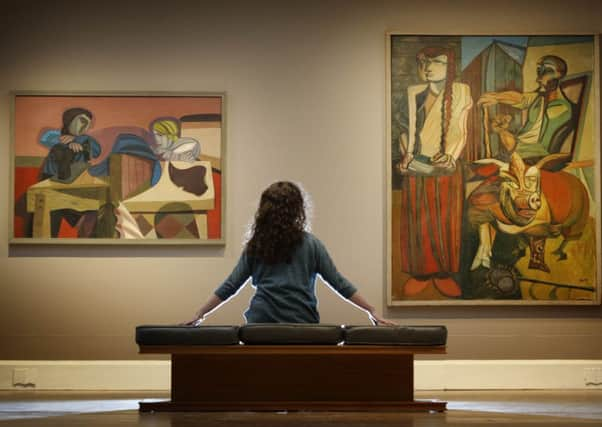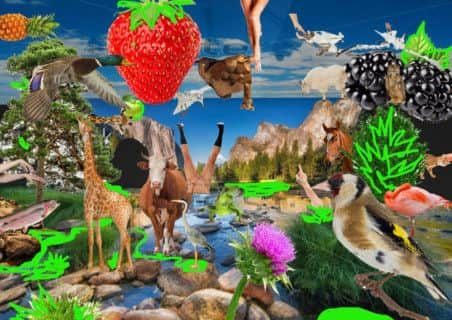Art review: Scotland’s best shows of 2014


SARAH LUCAS
The year began big and bawdy with Sarah Lucas’s unspeakably rude and pleasantly raucous show of sculptural works and photographs at Tramway in Glasgow. The bad girl of Brit Art is now a grande dame, but she hasn’t lost any of her mischief. These days, it’s good to be reminded just what an excellent, playful way she has always had with materials. MJ
ELLSWORTH KELLY


At 91, Ellsworth Kelly is is an old master of abstraction and a veteran of the post-war generation of artists who made American art international. His exhibition at the Ingleby Gallery in Edinburgh was a small show with small works but big impact. Kelly’s images are simple but intense. A rectangle or a diamond of pure colour, for instance, in which one of the four sides, instead of being straight, curves outwards, is typically subtle. So refined and so beautiful, in such works less is more. DM
TITIAN AND THE VENETIAN SCHOOL
Advertisement
Hide AdOne of the major events of the year was Titian at the Scottish National Gallery. Billed as Titian and the Venetian School, it brought together all the considerable range of Venetian works in the national collection. Much of this is beautiful. The works on paper being less familiar were especially good to see, but really everything else in the show was dwarfed by the impact of just three paintings: Titian’s Diana and Actaeon, his Diana and Callisto and his later painting of the Death of Actaeon on loan from London.These three stupendous paintings hung together and their collective impact outshone everything else in the gallery. No surprise really, for in a way everything important that followed in painting from Rubens and Rembrandt to Cézanne and Picasso is already implicit in those three great works. DM
BEDWYR WILLIAMS
Sarah McCrory has brought prodigious energy and vital new perspectives to her role as director of the Glasgow International Festival. If I didn’t love all of her first programme, it certainly boded well for the future. I did however adore one of her biggest commissions, hosted by Tramway: Bedwyr Williams’s funny, frightening film Echt, set in a dystopian future where new feudal lords display their wealth through excess casual clothing, including the wearing of multiple pairs of trainers and stacked up baseball caps. A scene featuring nightclub bouncers involved in extreme facial body-building exercises continued to amuse and terrify me in flashback for the rest of the year. MJ
RACHEL MACLEAN
The Generation project dominated Scotland’s galleries and museums this year. With more than 60 venues showing the work of artists who came to prominence in Scotland in the last quarter century. Key venues like the National Galleries of Scotland and the Gallery of Modern Art in Glasgow were rich in loans and classic works. I especially liked the ferocious inventiveness of Rachel Maclean, not yet 30, whose trilogy of films at CCA roamed through colonialism, austerity politics and the referendum without a po-faced lecture in sight. Maclean played all her characters herself: the sheer multiplicity of her faces, costumes and identities and the total commitment of her green screen technique were gob-smacking. MJ
JIM LAMBIE
Definitely a high point of the year, Lambie’s show at the Fruitmarket in Edinburgh was one of the best bits of the nationwide Generation project. There is a line of pure colour as music that links Lambie to Ellsworth Kelly (see above). But if Kelly’s exquisite prints are a beautiful solo, Lambie’s show was a whole jazz band in full swing. The brilliant, zig-zag, coloured stripes of Zobop lined the whole upper floor of the gallery, filled it with rhythm and even spilled down the stairs, just as the sound of a jazz band would have done. Downstairs, brightly painted ladders, the space between the rungs filled with mirrors, reflected the same irrepressible spirit. DM
STEVEN CAMPBELL
The other really memorable bit of Generation was the installation of the surviving part of Steven Campbell’s 1990 exhibition On Form and Fiction in a room of the Royal Scottish Academy, also in Edinburgh. In his show Campbell created a whole environment with framed paintings hung and lit like cinema screens and set in a field of unframed monochrome works on paper. Typically original, it not only linked painting with Campbell’s own passion for the cinema, but linked cinema in turn with the all-encompassing art of the baroque. Recreating his show was a tribute to one of the most original artists this country has produced for some time. DM
CLAIRE BARCLAY AND FIONA JARDINE
Amongst the madness of the Generation openings, a quiet weekend in Arbroath’s magnificent Hospitalfield House provided respite and nuance. Claire Barclay, whose sculptural work at the Scottish National Gallery of Modern Art was one of the most impressive new works in the Generation project, presented her first ever performance working with the estimable dancer and choreographer Janice Parker. Fiona Jardine’s three part event Let the Day Perish including a reading by Sue Tompkins, came to a memorable conclusion with a sound work featuring the growling cadences of Andy Pelc reading the words of Lewis Grassic Gibbon. MJ
DUNCAN CAMPBELL
Advertisement
Hide AdDuncan Campbell’s film, It for Others, on show at both The Common Guild and The Turner Prize exhibition at Tate Britain this year, was a demanding, frustrating and at times oblique mash-up of history, art theory and politics that split the critics. First commissioned for Scotland + Venice, its thorniness has also been its lasting virtue. Spanning subjects like colonialism, money, authorship and value, Campbell’s work explored the meaning of objects and their history. I can’t think of a move more unlikely than the sequence where the artist worked with the dancers of the Michael Clark Company to express complicated Marxist ideas through the medium of modern choreography. Campbell went on to win this year’s Turner Prize. MJ
HEATHER PHILLIPSON
Heather Phillipson’s cheerfully bonkers exhibition at Dundee Contemporary Arts featured films of talking cows, a flock of cut-out flamingos, giant earthworms and a pink-painted septic tank. The artist and poet is the very definition of a distinctive voice and her rumination on the animal world was the perfect antidote to the kind of insipid, nature-loving cliché favoured by the modern urban warrior. Phillipson insisted that nature wasn’t somewhere out there, but much closer to home: “I’m a salivating, urinating…animal,” she admitted in one of her voiceovers. “A pimple-forming, hair-growing piece of meat. I’m no more important than a cucumber.” MJ
REMBRANDT: THE LATE WORKS
Advertisement
Hide AdThe show of the year for me – indeed one of the best I have seen for many years – was Late Rembrandt at the National Gallery in London. Still on until 18 January, it brings together great paintings from the last 20 years of Rembrandt’s life. Pictures like The Jewish Bride, The Conspiracy of the Batavians under Claudius Civilis, the group portrait The Syndics and half a dozen of his late self-portraits would individually be worth travelling a long way to see. How much greater then is their collective impact? Overwhelming really, but it is also very modern. Seen like this it is clear that Rembrandt is no shadowy figure from the dusty past. His work is still very relevant to the way we live now. In our age of globalisation and of market forces that reduce us to powerless units of consumption, he reminds us of the better, more human values that have shaped our society. DM
THE TWO ROBERTS
A generation before Steven Campbell, Robert Colquhoun and Robert MacBryde, the two Roberts as they are always called, had a similar background to his in the west of Scotland. Their joint show at the National Gallery of Modern Art has revealed, too, how Colquhoun especially, like Campbell, was a painter of real power and originality and a leader of the generation that included Lucian Freud and Francis Bacon. Like them, Colquhoun was a master of the invocation of existential angst. Once again like Campbell, Colquhoun’s early death meant that the fame of his contemporaries has outshone his own. This show did much to put that right. DM